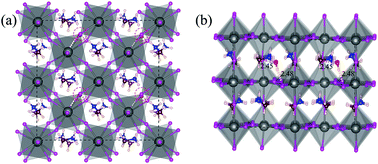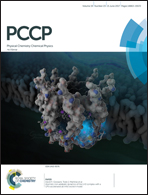Effect of water on the effective Goldschmidt tolerance factor and photoelectric conversion efficiency of organic–inorganic perovskite: insights from first-principles calculations†
Abstract
Water is often believed to be the leading killer of perovskite solar cells’ efficiency. However, recent experimental results show that perovskite solar cells have higher photoelectric conversion efficiency in a suitably moist environment. In this study, the relationship between the interstitial water molecule and the theoretical maximum efficiency of the perovskite absorber layer is discussed based on density functional theory calculations. Our calculated results show that an interstitial water molecule can enlarge the effective Goldschmidt tolerance factor, which is an empirical structural parameter for the structure of the perovskite material. The primitive MAPbI3 structure is not the ideal perovskite structure with the highest photoelectric conversion efficiency. Surprisingly, appropriate interstitial water molecules are beneficial to perovskite absorbers in terms of increasing photoelectric conversion efficiency. This can be attributed to the relatively larger effective Goldschmidt tolerance factor of the perovskite structure with an interstitial water molecule, which affects the photoelectric conversion efficiency of the perovskite structure. Our calculations indicate that the perovskite absorbers with a H2O : MAPbI3 ratio of 1/4–1/2 have a relatively higher photoelectric conversion efficiency. This study helps us understand the role of the interstitial molecule in the perovskite structure deeply, which is very useful in the design and optimization of the perovskite absorbers for high-efficiency perovskite cells.

- This article is part of the themed collection: 2017 PCCP HOT Articles


 Please wait while we load your content...
Please wait while we load your content...